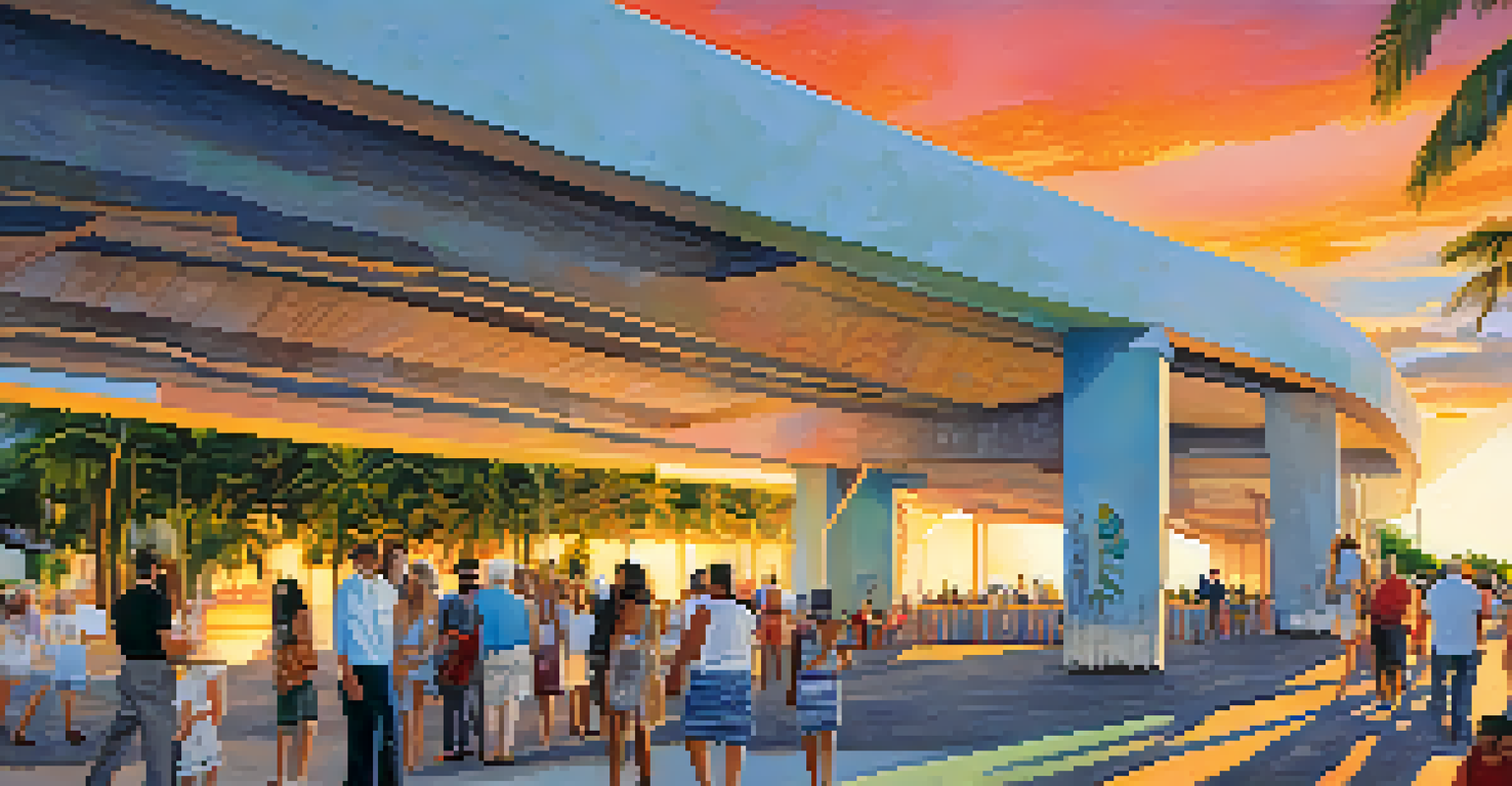The Rise of Modernism in Florida's Architectural Landscape

Understanding Modernism: A Brief Overview
Modernism emerged in the late 19th and early 20th centuries as artists and architects sought to break away from traditional styles. This movement emphasized functionality, simplicity, and the use of new materials and technologies. In Florida, modernism found a unique expression, influenced by the state's vibrant culture and natural environment.
The main thing is to have fun.
Essentially, modernism was about rethinking how buildings could relate to their surroundings and serve their inhabitants. It favored open spaces, clean lines, and a connection to the landscape, which resonated with Florida's sunny climate and picturesque coastlines. This architectural revolution was not just about aesthetics; it aimed to improve the quality of life through innovative design.
As modernism took root, it created a dialogue between the built environment and the natural world. Architects began to experiment with forms and materials that complemented Florida’s tropical setting, leading to a new architectural identity that was both functional and beautiful. This fusion laid the groundwork for the modernist movement in the Sunshine State.
The Influential Figures of Florida Modernism
Key architects played a pivotal role in shaping Florida's modernist landscape, with names like Paul Rudolph and Morris Lapidus leading the charge. Paul Rudolph, known for his brutalist designs, created structures that emphasized bold geometry and a strong relationship with the environment. His work, including the Sarasota School of Architecture, pushed boundaries and inspired a generation of architects.

Morris Lapidus, on the other hand, brought a playful, whimsical approach to modernism. His designs, particularly for Miami Beach hotels, embraced bright colors and curved shapes, capturing Florida's vibrant spirit. Lapidus famously said, 'The main thing is to have fun,' a philosophy that resonated in his iconic structures.
Modernism Transformed Florida's Design
The modernist movement in Florida redefined architectural norms by prioritizing functionality, open spaces, and a connection to the natural environment.
These architects were not just designers; they were visionaries who understood the unique cultural and environmental context of Florida. Their innovative approaches helped to establish a modernist identity that celebrated the state's diversity while also addressing the needs of its residents. This blend of creativity and practicality made their contributions unforgettable.
Modernism's Impact on Florida's Urban Development
As modernism spread across Florida, it significantly influenced urban development and planning. Cities like Miami and Sarasota underwent transformations, with modernist buildings becoming symbols of progress and innovation. The emphasis on open spaces and functional designs led to more livable urban environments, where people could enjoy both nature and modern amenities.
Architecture should speak of its time and place, but yearn for timelessness.
Modernist architecture also encouraged a departure from the rigid, traditional layouts of older neighborhoods. Instead, planners began to create communities that fostered social interaction, with parks, plazas, and walkable streets integrated into the design. This shift not only enhanced the aesthetic appeal but also improved the quality of life for residents.
Moreover, the modernist movement helped to redefine Florida's identity on a national scale. As cities embraced modern architecture, they attracted tourists and new residents, eager to experience the vibrant, innovative culture. This influx contributed to the state's rapid growth and development, solidifying its place as a hub for modern design.
Key Characteristics of Florida Modernist Architecture
Florida modernist architecture is distinguished by its emphasis on light, space, and nature. Large windows and open floor plans are common features, allowing for a seamless flow between indoor and outdoor environments. This design philosophy not only maximizes natural light but also fosters a deep appreciation for Florida's stunning landscapes.
Another characteristic of this style is the use of innovative materials, such as concrete and glass. These materials enable architects to create bold, sculptural forms that stand out against the backdrop of the state's lush greenery and sparkling waters. The interplay of textures and colors further enhances the visual appeal of modernist buildings.
Key Architects Shaped Modernism
Influential figures like Paul Rudolph and Morris Lapidus played crucial roles in establishing Florida's unique modernist identity through their innovative designs.
Additionally, modernist architecture in Florida often incorporates elements of tropical design, such as overhangs and shading devices. These features help to combat the state's heat and humidity while maintaining a connection to the outdoors. This thoughtful approach to design reflects a deep understanding of the local climate and environment.
Revitalizing Florida's Historic Modernist Structures
As modernism gained traction in Florida, many historic buildings from this era faced neglect and potential demolition. However, recent efforts to preserve and revitalize these structures have highlighted their cultural significance. Restoration projects not only save architectural gems but also celebrate Florida's rich modernist heritage.
Organizations and local governments have recognized the importance of these buildings in telling the story of Florida's architectural evolution. By restoring structures like the Miami Marine Stadium and the Bacardi Building, they are fostering a sense of pride and connection to the past. These revitalized spaces serve as reminders of the innovative spirit that characterized the modernist movement.
Moreover, these preservation efforts often involve community engagement, bringing residents together to appreciate their architectural history. Events, tours, and educational programs help to raise awareness and encourage a deeper understanding of modernism's impact on Florida's identity. This collective effort ensures that Florida's modernist legacy will continue to inspire future generations.
Modernism and Florida's Cultural Identity
The rise of modernism in Florida is closely intertwined with the state's cultural identity. As a melting pot of diverse influences, Florida's architecture reflects the rich tapestry of its inhabitants and their experiences. Modernist buildings often serve as cultural landmarks, representing the aspirations and creativity of the communities they inhabit.
Art and culture flourished alongside modernist architecture, with artists, musicians, and writers finding inspiration in the innovative designs and open spaces. This synergy between modernism and the arts helped to cultivate a vibrant cultural scene, attracting talents from across the nation. Florida became a canvas for artistic expression, where architecture and art coexisted and thrived.
Preservation of Modernist Heritage
Recent efforts to revitalize historic modernist structures highlight their cultural significance and connection to Florida's architectural evolution.
Furthermore, modernism's emphasis on community engagement and inclusivity aligns with Florida's diverse population. Architects and planners sought to create spaces that welcomed everyone, fostering social connections and a sense of belonging. This commitment to inclusivity continues to shape Florida's architectural landscape today, making it a truly unique destination.
The Future of Modernism in Florida
As we look to the future, the principles of modernism remain relevant in Florida's architectural landscape. New generations of architects are drawing inspiration from the past while integrating contemporary design trends and sustainable practices. This evolution of modernism reflects a growing awareness of environmental responsibilities and the need for resilient design amidst climate change.
Innovations in technology and materials are also reshaping the way modernist principles are applied. Architects are exploring new possibilities for energy-efficient designs, smart home technologies, and eco-friendly materials, ensuring that modernism adapts to current challenges. This forward-thinking approach allows Florida to maintain its status as a leader in architectural innovation.

Ultimately, the future of modernism in Florida will hinge on the ability to balance tradition with progress. By honoring the legacy of past architects while embracing new ideas, Florida's architectural landscape will continue to evolve, capturing the essence of its vibrant culture and stunning environment. The journey of modernism in Florida is far from over, and the possibilities are as bright as the state's sunshine.